Photos:
a. KL from the KL tower, one of those big and famous communication towers.
b. Condos which are everywhere in KL.
c. The Batu caves and steps.
d. Me with a new friend (it was strong, heavy, and did not like me)
e. China Town
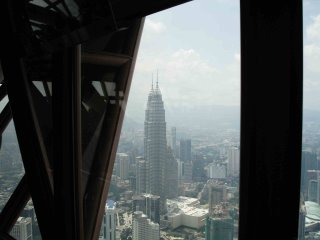
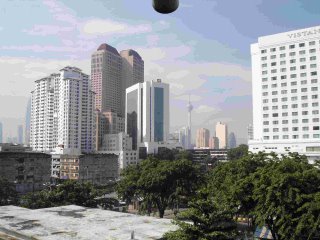
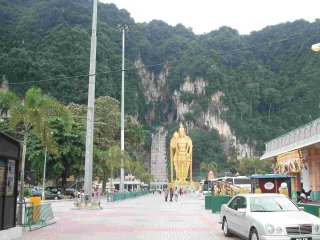
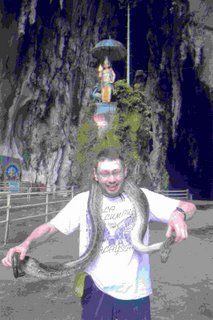
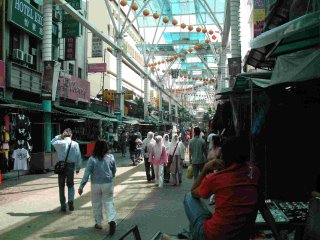
I left Singapore and arrived in Malaysia on a train. This journey began with a comical pass through customs at the Sing train station. My passport was scanned by a Malay woman hidden behind a glass screen, who said something through a speaker grill which I could not understand, and then waved me on. Next three uniformed customs inspectors, without moving from a reclining position, declined to inspect my luggage. My personal feeling is that border control is a joke and merely gives lots of people make work.
The train trip was uneventful, as was the arrival at the hi-tech KL Sentral Train Station (with a wireless, broadband Starbucks—class). All this was soon to change: In Singapore I had stayed in a 5 star, but had I decided to go down market in KL, get closer to the ‘real’ city! I had consulted that repository of knowledge ‘The Lonely Planet (if I had $1 for every LP book I have seen so far...) cheapo guide to SE Asia’ and found the New China Inn in KLs China Town: it is cheap, clean and has the basic amenities (and at a mere RM80 (Ringgit) ~A$30 hard to beat for price). So I booked a room from Sing.
After a 10 minute drive the taxi pulled up in front of a seething mass of humanity. There were stalls and shops filling the streets, people were shouting, bustling, buying, selling, running, walking, but not standing still. A constant melange of sight and sound, with zero free space (or at least that is how it looked). Then the driver informed me that he could go no further as the hotel was located inside China Town, which was not accessible by car. Yikes! This innocent young boy from Perth was immediately seized with the thought that his body would be found (if he was lucky) in a few days, stripped of any valuables and thrown onto a rubbish heap. However, nothing ventured nothing gained. I strode from the taxi into China Town with only a minimal sense of where I was going.
I did not get get very far: I was lugging a heavy backpack and a big bag, there was no walking space, and I was too stunned and busy looking at everything around me. However, after a few minutes of emulating a guppy out of water I realised that most people were ignoring me, most of those few who were not were (politely) waiting for me to move out of the way, the few people who were actually interested in me were screaming: ‘sir, sir, watch, a watch, a rolex?’, ‘T-shirt sir, T-shirt?’, ‘DVD, DVD sir?’, etc. I slowly began to move, and in the fullness of time found my hotel, and the manager of my hotel, James, who proved to be a font of useful information about KL and Malaysia.
I spent a week in KL, it is a fascinating place: noisy and vibrant, varied and traditional, exciting but never quiet. In some ways it is not a single city, different areas are so dissimilar that it is more a series of small towns clustered close to each other. I spent the first two days in KL simply looking around. This meant for me wandering the streets, riding back and forth on the monorail and the elevated train (KL has an excellent public transport system), and browsing through shops. What was surprising was the contrast between people, some were dressed in semi-traditional garb, others in suits, some women wore Muslim dress, others western. This meant that sometimes a daughter would dress like Britney Spears while her mother walking next to her would resemble the Ayatollah Kohmeni.
A word on personal safety. There was no danger, I wandered everywhere and never felt the slightest risk. My worst concern was being able to answer the innumerable soccer related questions I was often asked. However, I was warned by several locals against financial scams. Several people did stop me in the street, ask where I was from, and then ask if I could talk to their uncle who wished to work or immigrate to Australia.
This does lead into my one KL adventure. On my second day a woman (Amy) stopped me and started chatting. It then came out that she had an uncle who wanted to immigrate to Australia and could I fund time to come to her house and talk to him about the Big Island? Needless to say I was a little doubtful. I asked the manager of my hotel what he thought, his conclusion was that it was some sort of investment scam—get the isolated tourists to sign something. Amy had given me her mobile number, and after a few more days, after I had concluded that I was an experienced KL adventurer, I decided to give her a call and arrange a meeting. What made me a little doubtful was her refusal to meet in a public place, and her increasingly implausible reasons for refusing to do so. James, my hotel manager and confidant, advised me not to go, however, nothing ventured... At worst, any nefarious plan would merely involve an attempt to extort money from me, so I only took a RM 100 with me, and no credit cards or ID, and I left Amy’s number with James with a request to call the cavalry if I was not back within three hours.
To cut a long story short, Amy did have an uncle, an electrician by trade, who wanted to visit Australia and look for work with a view to immigrating. The reason that Amy wanted me to visit her house was that she was proud of it and wanted me to see it for myself. Overall, a pleasant two hours of chit chat. As her uncle wanted to live in Brisbane I could give only general advice, however, I assured him that Australia was safe and was looking for experienced workers.
At this point I will divert from my autobiographical ranting and address some advice to ‘the Ladies’—when in KL wear sensible shoes. The reason that I mention this is that the streets of KL are not the best. The footpaths are smooth and dirty, when wet they become muddy and slippery. I saw several backpacker chicks wearing thongs or sandals slip and slide. The footpaths are also often damaged, uneven, and sometimes have the odd big hole. So, no heels or open shoes—sensible shoes.
This leads me to another digression. Most Malays speak several languages with varying degrees of proficiency. My hotel manager can speak five languages. In contrast the average native English speaker can speak precisely one language. This means of course that each and every Malay is embarrassed by their low proficiency in English and apologised for their inability to speak English as well as an idiotic American reality TV show participant. As a native speaker of English I can only say one thing about this self-imposed inferiority complex—fan-tas-tic!
One of the highlights of KL tourism is a visit to the Batu Caves. These are located a mere 13kms from KL and consist of a main cave set into a rock face, plus a few smaller caves close by. In days past these caves have been turned into a Hindu temple area. To reach the caves one must ascend 150 metres, via 272 steps. Needless to say, while there are a number of true devotees in the caves, the overwhelming number are tourists busily photographing everything in sight. As one of these camera happy tourists I climbed the steps, wandered through the cave system, looked at the statues of the gods, gazed at the cave structure, had my photo taken holding a snake, and looked at the art gallery. Lots of fun. I travelled there and back on a public bus for the princely sum of RM2.40 (about Aus 80c).
It was after my return from the Batu Caves, my fifth day in KL, that I saw a most comical sight. In the early evening I was sitting outside the China Town Swiss Inn, enjoying a refreshing Pineapple juice as had become my custom, when I saw two lanky lads stumble down the street overburdened with possessions in search, one presumes, of their hotel. They looked totally lost and confused. Honestly! Have these people never been out of their home village?
There was one other minor annoyance I came across—financially stringent backpackers. On more than a few occasions I walked past backpackers arguing with street vendors over the price of a meal, a matter of a few cents either way. The same thing in cheap hotels. Come on guys, no matter how poor you are by western standards a few cents (or even a few dollars a night) is going to make a big difference to your travel plans, but it is a big deal to the locals you are bargaining with.
Melaka
Melaka is a city and region reeking with history. In days past empires battled and pirates raided over its shores. It lies about 150 km south of KL, and is easily reached by two hours on a bus. I decided to take a day our of my busy KL schedule and check it all out. The bus ride was uneventful, but the city was fascinating. There is a surprisingly large and well designed museum in the town square, along with other buildings left over from the old days of empire. I spent a day wandering around Melaka, looking at its large range of touristy things, and buying a few souvenirs. Well worth a visit. It is the quietest place I had visited so far.
A few more insights into life as a traveller. I have found my ipod an invaluable companion, travel involves a lot of hurry and wait. To pass the time the pleasant voice of podcaster describing some esoteric feat of science, technology or culture is an excellent anodyne to the ennui of life on the road. One minor annoyance was airconditioning, many places, even those which catered to the locals had their aircon set to frosty. I would walk out of a hotel or bus and my glasses would fog over. Such are the problems of the traveller.
I left KL with a certain amount of regret, something I did not experience when departing Singapore. KL is city everyone should see at least once. Onwards to Penang!
a. KL from the KL tower, one of those big and famous communication towers.
b. Condos which are everywhere in KL.
c. The Batu caves and steps.
d. Me with a new friend (it was strong, heavy, and did not like me)
e. China Town





I left Singapore and arrived in Malaysia on a train. This journey began with a comical pass through customs at the Sing train station. My passport was scanned by a Malay woman hidden behind a glass screen, who said something through a speaker grill which I could not understand, and then waved me on. Next three uniformed customs inspectors, without moving from a reclining position, declined to inspect my luggage. My personal feeling is that border control is a joke and merely gives lots of people make work.
The train trip was uneventful, as was the arrival at the hi-tech KL Sentral Train Station (with a wireless, broadband Starbucks—class). All this was soon to change: In Singapore I had stayed in a 5 star, but had I decided to go down market in KL, get closer to the ‘real’ city! I had consulted that repository of knowledge ‘The Lonely Planet (if I had $1 for every LP book I have seen so far...) cheapo guide to SE Asia’ and found the New China Inn in KLs China Town: it is cheap, clean and has the basic amenities (and at a mere RM80 (Ringgit) ~A$30 hard to beat for price). So I booked a room from Sing.
After a 10 minute drive the taxi pulled up in front of a seething mass of humanity. There were stalls and shops filling the streets, people were shouting, bustling, buying, selling, running, walking, but not standing still. A constant melange of sight and sound, with zero free space (or at least that is how it looked). Then the driver informed me that he could go no further as the hotel was located inside China Town, which was not accessible by car. Yikes! This innocent young boy from Perth was immediately seized with the thought that his body would be found (if he was lucky) in a few days, stripped of any valuables and thrown onto a rubbish heap. However, nothing ventured nothing gained. I strode from the taxi into China Town with only a minimal sense of where I was going.
I did not get get very far: I was lugging a heavy backpack and a big bag, there was no walking space, and I was too stunned and busy looking at everything around me. However, after a few minutes of emulating a guppy out of water I realised that most people were ignoring me, most of those few who were not were (politely) waiting for me to move out of the way, the few people who were actually interested in me were screaming: ‘sir, sir, watch, a watch, a rolex?’, ‘T-shirt sir, T-shirt?’, ‘DVD, DVD sir?’, etc. I slowly began to move, and in the fullness of time found my hotel, and the manager of my hotel, James, who proved to be a font of useful information about KL and Malaysia.
I spent a week in KL, it is a fascinating place: noisy and vibrant, varied and traditional, exciting but never quiet. In some ways it is not a single city, different areas are so dissimilar that it is more a series of small towns clustered close to each other. I spent the first two days in KL simply looking around. This meant for me wandering the streets, riding back and forth on the monorail and the elevated train (KL has an excellent public transport system), and browsing through shops. What was surprising was the contrast between people, some were dressed in semi-traditional garb, others in suits, some women wore Muslim dress, others western. This meant that sometimes a daughter would dress like Britney Spears while her mother walking next to her would resemble the Ayatollah Kohmeni.
A word on personal safety. There was no danger, I wandered everywhere and never felt the slightest risk. My worst concern was being able to answer the innumerable soccer related questions I was often asked. However, I was warned by several locals against financial scams. Several people did stop me in the street, ask where I was from, and then ask if I could talk to their uncle who wished to work or immigrate to Australia.
This does lead into my one KL adventure. On my second day a woman (Amy) stopped me and started chatting. It then came out that she had an uncle who wanted to immigrate to Australia and could I fund time to come to her house and talk to him about the Big Island? Needless to say I was a little doubtful. I asked the manager of my hotel what he thought, his conclusion was that it was some sort of investment scam—get the isolated tourists to sign something. Amy had given me her mobile number, and after a few more days, after I had concluded that I was an experienced KL adventurer, I decided to give her a call and arrange a meeting. What made me a little doubtful was her refusal to meet in a public place, and her increasingly implausible reasons for refusing to do so. James, my hotel manager and confidant, advised me not to go, however, nothing ventured... At worst, any nefarious plan would merely involve an attempt to extort money from me, so I only took a RM 100 with me, and no credit cards or ID, and I left Amy’s number with James with a request to call the cavalry if I was not back within three hours.
To cut a long story short, Amy did have an uncle, an electrician by trade, who wanted to visit Australia and look for work with a view to immigrating. The reason that Amy wanted me to visit her house was that she was proud of it and wanted me to see it for myself. Overall, a pleasant two hours of chit chat. As her uncle wanted to live in Brisbane I could give only general advice, however, I assured him that Australia was safe and was looking for experienced workers.
At this point I will divert from my autobiographical ranting and address some advice to ‘the Ladies’—when in KL wear sensible shoes. The reason that I mention this is that the streets of KL are not the best. The footpaths are smooth and dirty, when wet they become muddy and slippery. I saw several backpacker chicks wearing thongs or sandals slip and slide. The footpaths are also often damaged, uneven, and sometimes have the odd big hole. So, no heels or open shoes—sensible shoes.
This leads me to another digression. Most Malays speak several languages with varying degrees of proficiency. My hotel manager can speak five languages. In contrast the average native English speaker can speak precisely one language. This means of course that each and every Malay is embarrassed by their low proficiency in English and apologised for their inability to speak English as well as an idiotic American reality TV show participant. As a native speaker of English I can only say one thing about this self-imposed inferiority complex—fan-tas-tic!
One of the highlights of KL tourism is a visit to the Batu Caves. These are located a mere 13kms from KL and consist of a main cave set into a rock face, plus a few smaller caves close by. In days past these caves have been turned into a Hindu temple area. To reach the caves one must ascend 150 metres, via 272 steps. Needless to say, while there are a number of true devotees in the caves, the overwhelming number are tourists busily photographing everything in sight. As one of these camera happy tourists I climbed the steps, wandered through the cave system, looked at the statues of the gods, gazed at the cave structure, had my photo taken holding a snake, and looked at the art gallery. Lots of fun. I travelled there and back on a public bus for the princely sum of RM2.40 (about Aus 80c).
It was after my return from the Batu Caves, my fifth day in KL, that I saw a most comical sight. In the early evening I was sitting outside the China Town Swiss Inn, enjoying a refreshing Pineapple juice as had become my custom, when I saw two lanky lads stumble down the street overburdened with possessions in search, one presumes, of their hotel. They looked totally lost and confused. Honestly! Have these people never been out of their home village?
There was one other minor annoyance I came across—financially stringent backpackers. On more than a few occasions I walked past backpackers arguing with street vendors over the price of a meal, a matter of a few cents either way. The same thing in cheap hotels. Come on guys, no matter how poor you are by western standards a few cents (or even a few dollars a night) is going to make a big difference to your travel plans, but it is a big deal to the locals you are bargaining with.
Melaka
Melaka is a city and region reeking with history. In days past empires battled and pirates raided over its shores. It lies about 150 km south of KL, and is easily reached by two hours on a bus. I decided to take a day our of my busy KL schedule and check it all out. The bus ride was uneventful, but the city was fascinating. There is a surprisingly large and well designed museum in the town square, along with other buildings left over from the old days of empire. I spent a day wandering around Melaka, looking at its large range of touristy things, and buying a few souvenirs. Well worth a visit. It is the quietest place I had visited so far.
A few more insights into life as a traveller. I have found my ipod an invaluable companion, travel involves a lot of hurry and wait. To pass the time the pleasant voice of podcaster describing some esoteric feat of science, technology or culture is an excellent anodyne to the ennui of life on the road. One minor annoyance was airconditioning, many places, even those which catered to the locals had their aircon set to frosty. I would walk out of a hotel or bus and my glasses would fog over. Such are the problems of the traveller.
I left KL with a certain amount of regret, something I did not experience when departing Singapore. KL is city everyone should see at least once. Onwards to Penang!
Comments